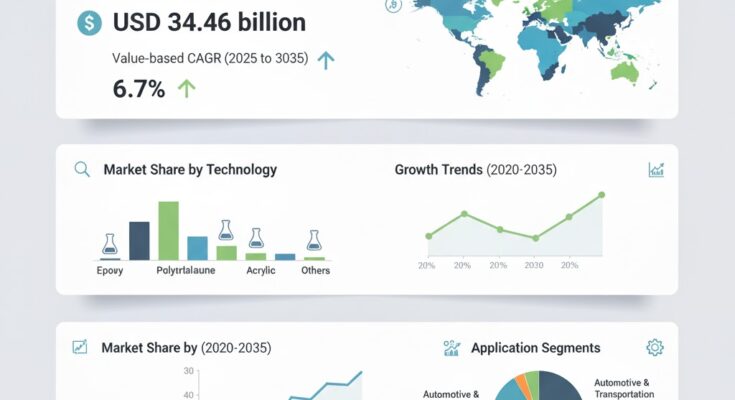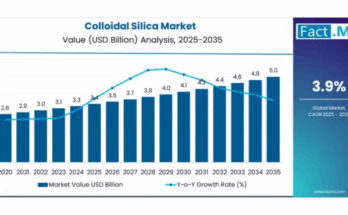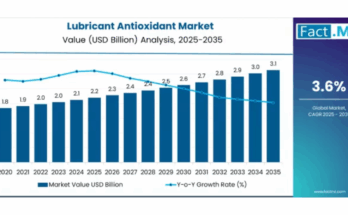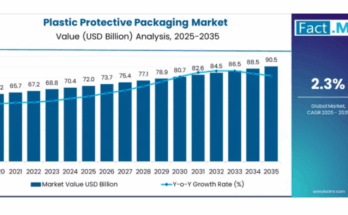The global structural adhesives market is poised for remarkable expansion, supported by rising demand from the automotive, aerospace, construction, and renewable energy sectors. According to a recent report by Fact.MR, the market is projected to rise from US$ 18.43 billion in 2025 to US$ 34.46 billion by 2035, reflecting a robust CAGR of 6.7% over the forecast period.
Structural adhesives, known for their superior bonding strength and ability to join dissimilar materials, are gaining traction as industries shift toward lightweighting, sustainability, and high-performance manufacturing solutions.
Strategic Market Drivers
- Rising Adoption in Automotive and Aerospace Applications
The automotive and aerospace sectors remain major consumers of structural adhesives. As manufacturers aim to reduce vehicle and aircraft weight to enhance fuel efficiency and reduce emissions, structural adhesives are replacing traditional mechanical fasteners such as rivets and welds.
In automotive manufacturing, these adhesives are extensively used for bonding metals, composites, and plastics in body panels and structural assemblies. Similarly, in aerospace, their exceptional fatigue resistance, durability, and performance under extreme conditions have made them essential for fuselage and wing bonding applications.
- Infrastructure and Construction Growth Stimulates Demand
Rapid urbanization and infrastructure development, especially in Asia-Pacific and the Middle East, are driving the need for high-performance structural bonding materials. Structural adhesives are increasingly utilized in construction for curtain walls, panel bonding, composite structures, and modular building systems.
Their ability to provide strong, durable, and weather-resistant joints makes them integral to modern architectural designs focused on energy efficiency and sustainability.
- Expanding Use in Renewable Energy and Electronics
The renewable energy sector, particularly wind and solar energy, is emerging as a significant growth area. Structural adhesives are used in wind turbine blade assembly, solar panel lamination, and other composite bonding applications that demand long-term strength and flexibility.
In electronics manufacturing, their precise application and electrical insulation properties enhance component reliability, contributing to safer and more efficient products.
Regional Growth Highlights
East Asia: Dominant Manufacturing Hub
East Asia leads global demand, driven by its robust automotive, electronics, and construction industries. China, Japan, and South Korea are at the forefront of adopting advanced adhesive technologies, backed by strong industrial policies and R&D initiatives.
Growing investments in EV production and smart manufacturing are further propelling market expansion in the region.
North America: Innovation and High-Performance Material Development
North America continues to witness substantial growth due to technological innovation and strong demand from the aerospace and defense sectors. The region’s emphasis on sustainable manufacturing and lightweight material integration positions it as a key hub for structural adhesive innovation.
Europe: Regulation and Green Manufacturing Drive Market Evolution
Europe’s market is characterized by stringent environmental standards and a strong focus on low-emission, energy-efficient adhesive formulations. Countries such as Germany, the U.K., and France are investing in research for bio-based adhesives and advanced composite materials to comply with EU sustainability goals.
Emerging Economies: Infrastructure-Led Growth
Rapid industrialization and infrastructure development across Latin America, South Asia, and the Middle East are fueling demand for durable and cost-effective bonding solutions. Increasing construction activity and the expansion of automotive manufacturing bases in these regions are unlocking new growth opportunities.
Market Segmentation Insights
By Type
- Epoxy Adhesives: Preferred for their high shear strength and resistance to heat and chemicals.
- Acrylic Adhesives: Gaining traction for fast-curing applications and excellent adhesion to metals and composites.
- Polyurethane Adhesives: Known for their flexibility and impact resistance, ideal for dynamic load-bearing applications.
- Cyanoacrylate and Others: Used in specialized bonding applications across medical and electronic sectors.
By End Use Industry
- Automotive & Transportation: Dominates the market with increasing EV production and lightweighting initiatives.
- Building & Construction: Rising adoption for panel bonding, structural glazing, and composite reinforcement.
- Aerospace: Expanding use in aircraft assembly, composite bonding, and maintenance operations.
- Renewable Energy & Electronics: Growing utilization in wind turbine blades, solar modules, and component encapsulation.
Challenges and Market Considerations
Despite a strong growth trajectory, the structural adhesives market faces several challenges:
- Raw Material Price Volatility: Fluctuating costs of petrochemical-based resins affect production and pricing.
- Environmental Regulations: Increasing demand for low-VOC and recyclable adhesives necessitates continuous R&D investments.
- Processing Limitations: Precise surface preparation and curing conditions remain critical for achieving optimal performance.
- Competition from Mechanical Fasteners and Welding: Traditional joining methods still dominate in cost-sensitive applications.
Competitive Landscape
The global structural adhesives market is highly competitive, with manufacturers focusing on product innovation, sustainability, and industry-specific solutions. Key strategies include developing bio-based adhesives, expanding production capacities, and investing in automation-enabled dispensing technologies.
Key Companies Profiled:
- 3M Company
- Sika AG
- Henkel AG & Co. KGaA
- The Dow Chemical Company
- H.B. Fuller
- Scott Bader Co.
- Uniseal Inc.
- Huntsman Corporation
- Ashland Inc.
- Lord Corporation
- Illinois Tool Works Inc.
- Permabond LLC
- MAPEI
- Ardex
Recent Developments
- March 2023 – Sika AG expanded its adhesive production facility in the U.S. to cater to growing demand from automotive and renewable energy sectors.
- June 2022 – Henkel launched a new range of high-strength, low-VOC structural adhesives under its LOCTITE brand, emphasizing sustainability and high-speed curing.
- September 2022 – H.B. Fuller introduced its next-generation epoxy systems tailored for aerospace composite bonding, offering enhanced durability and reduced curing time.
Future Outlook: Toward Sustainable and High-Performance Bonding Solutions
The next decade will mark a transformative phase for the structural adhesives market, driven by green chemistry, lightweighting, and digital manufacturing integration. Advancements in nano-adhesive formulations, smart curing systems, and automation-compatible solutions are set to redefine performance benchmarks.
As industries continue to prioritize energy efficiency and carbon reduction, structural adhesives will play a pivotal role in enabling sustainable product design and efficient assembly. Companies that invest in sustainable innovation, collaborative partnerships, and localized production will lead the next wave of growth in the global structural adhesives market creating durable, efficient, and eco-friendly bonding solutions for a connected industrial future.



